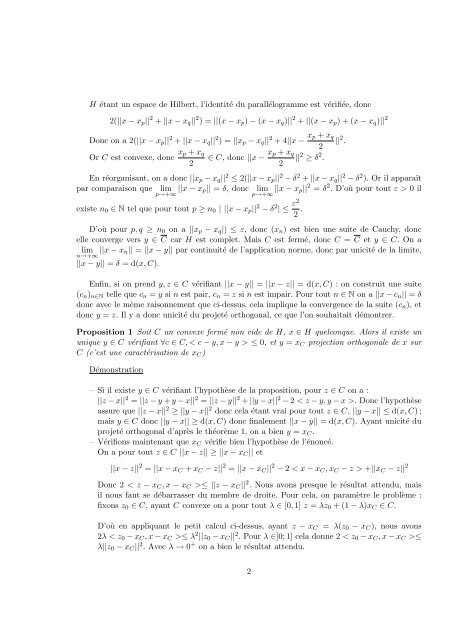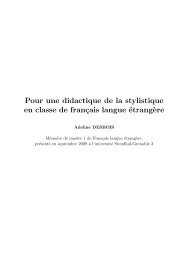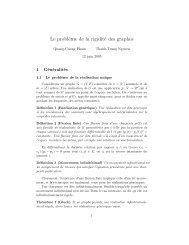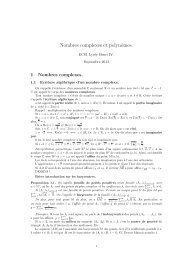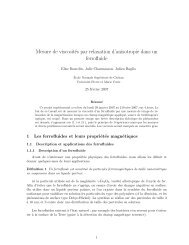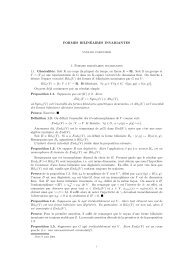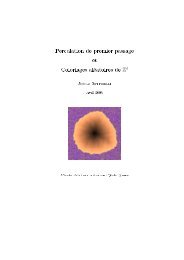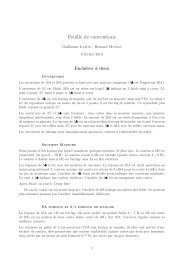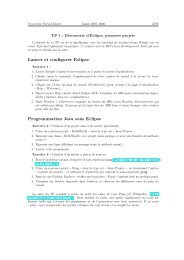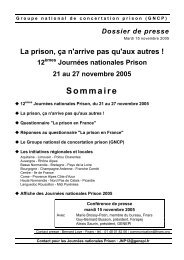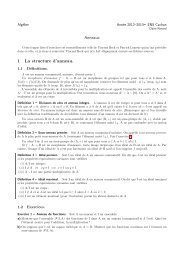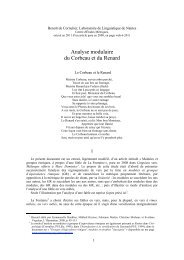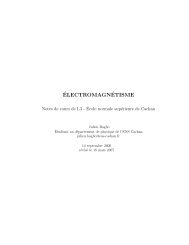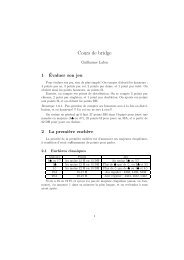Le théorème de représentation de Riesz dans un ... - Normalesup.org
Le théorème de représentation de Riesz dans un ... - Normalesup.org
Le théorème de représentation de Riesz dans un ... - Normalesup.org
You also want an ePaper? Increase the reach of your titles
YUMPU automatically turns print PDFs into web optimized ePapers that Google loves.
H étant <strong>un</strong> espace <strong>de</strong> Hilbert, l’i<strong>de</strong>ntité du parallélogramme est vérifiée, donc<br />
2(||x − xp|| 2 + ||x − xq|| 2 ) = ||(x − xp) − (x − xq)|| 2 + ||(x − xp) + (x − xq)|| 2<br />
Donc on a 2(||x − xp|| 2 + ||x − xq|| 2 ) = ||xp − xq|| 2 + 4||x − xp + xq<br />
Or C est convexe, donc xp + xq<br />
2<br />
∈ C, donc ||x − xp + xq<br />
2<br />
2<br />
|| 2 ≥ δ 2 .<br />
En ré<strong>org</strong>anisant, on a donc ||xp − xq|| 2 ≤ 2(||x − xp|| 2 − δ2 + ||x − xq|| 2 − δ2 ). Or il apparaît<br />
par comparaison que lim<br />
p→+∞ ||x − xp|| = δ, donc lim<br />
p→+∞ ||x − xp|| 2 = δ 2 . D’où pour tout ε > 0 il<br />
existe n0 ∈ N tel que pour tout p ≥ n0 | ||x − xp|| 2 − δ 2 | ≤ ε2<br />
2 .<br />
D’où pour p, q ≥ n0 on a ||xp − xq|| ≤ ε, donc (xn) est bien <strong>un</strong>e suite <strong>de</strong> Cauchy, donc<br />
elle converge vers y ∈ C car H est complet. Mais C est fermé, donc C = C et y ∈ C. On a<br />
lim<br />
n→+∞ ||x − xn|| = ||x − y|| par continuité <strong>de</strong> l’application norme, donc par <strong>un</strong>icité <strong>de</strong> la limite,<br />
||x − y|| = δ = d(x, C).<br />
Enfin, si on prend y, z ∈ C vérifiant ||x − y|| = ||x − z|| = d(x, C) : on construit <strong>un</strong>e suite<br />
(cn)n∈N telle que cn = y si n est pair, cn = z si n est impair. Pour tout n ∈ N on a ||x − cn|| = δ<br />
donc avec le même raisonnement que ci-<strong>de</strong>ssus, cela implique la convergence <strong>de</strong> la suite (cn), et<br />
donc y = z. Il y a donc <strong>un</strong>icité du projeté orthogonal, ce que l’on souhaitait démontrer.<br />
Proposition 1 Soit C <strong>un</strong> convexe fermé non vi<strong>de</strong> <strong>de</strong> H, x ∈ H quelconque. Alors il existe <strong>un</strong><br />
<strong>un</strong>ique y ∈ C vérifiant ∀c ∈ C, < c − y, x − y > ≤ 0, et y = xC projection orthogonale <strong>de</strong> x sur<br />
C (c’est <strong>un</strong>e caractérisation <strong>de</strong> xC)<br />
Démonstration<br />
– Si il existe y ∈ C vérifiant l’hypothèse <strong>de</strong> la proposition, pour z ∈ C on a :<br />
||z − x|| 2 = ||z − y + y − x|| 2 = ||z − y|| 2 + ||y − x|| 2 − 2 < z − y, y − x >. Donc l’hypothèse<br />
assure que ||z − x|| 2 ≥ ||y − x|| 2 donc cela étant vrai pour tout z ∈ C, ||y − x|| ≤ d(x, C) ;<br />
mais y ∈ C donc ||y − x|| ≥ d(x, C) donc finalement ||x − y|| = d(x, C). Ayant <strong>un</strong>icité du<br />
projeté orthogonal d’après le <strong>théorème</strong> 1, on a bien y = xC.<br />
– Vérifions maintenant que xC vérifie bien l’hypothèse <strong>de</strong> l’énoncé.<br />
On a pour tout z ∈ C ||x − z|| ≥ ||x − xC|| et<br />
||x − z|| 2 = ||x − xC + xC − z|| 2 = ||x − xC|| 2 − 2 < x − xC, xC − z > +||xC − z|| 2<br />
Donc 2 < z − xC, x − xC >≤ ||z − xC|| 2 . Nous avons presque le résultat attendu, mais<br />
il nous faut se débarrasser du membre <strong>de</strong> droite. Pour cela, on paramètre le problème :<br />
fixons z0 ∈ C, ayant C convexe on a pour tout λ ∈ [0, 1] z = λz0 + (1 − λ)xC ∈ C.<br />
D’où en appliquant le petit calcul ci-<strong>de</strong>ssus, ayant z − xC = λ(z0 − xC), nous avons<br />
2λ < z0 − xC, x − xC >≤ λ 2 ||z0 − xC|| 2 . Pour λ ∈]0; 1] cela donne 2 < z0 − xC, x − xC >≤<br />
λ||z0 − xC|| 2 . Avec λ → 0 + on a bien le résultat attendu.<br />
2<br />
|| 2 .


